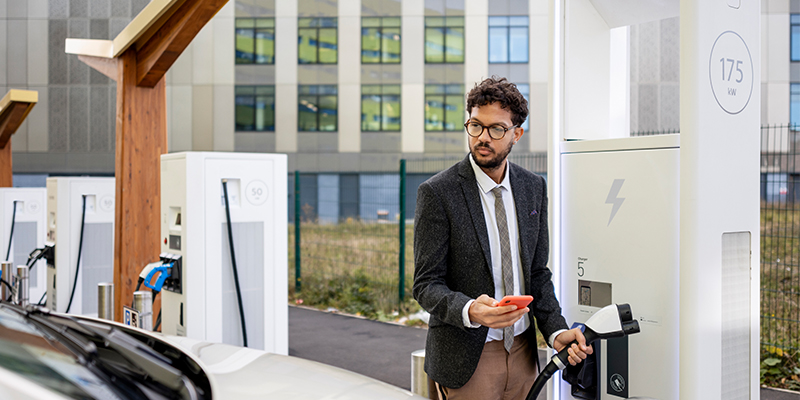Cities and counties are increasingly adopting local ordinances that are intended to spur the electrification of our transportation system in order to reduce greenhouse gas (GHG) emissions from fossil fuels. A survey by The U.S. Conference of Mayors identified electric vehicles (EVs) “as the most promising technology for reducing energy use and carbon emissions in their cities.” Local efforts to support the use of EVs by both the public and private sectors will require the development and expansion of a reliable and sustainable EV charging system.
Efforts by mayors and local governments to transform the nation’s transportation system from fossil-fueled vehicles to electric ones has been boosted by the federal government and the private automobile industry. Both the Biden Administration and major U.S. carmakers – Ford, General Motors and Stellantis (Chrysler) – have set aspirational goals for EVs to account for 50% of all vehicle sales by 2030. These aspirational goals reflect growing consumer interest for electric vehicles that will further accelerate the demand for a sustainable EV charging network across the United States.
Mayors and local officials are implementing policies and ordinances to quickly expand the number of charging stations in recognition of the increasing momentum for EVs within their communities. According to Axios, local efforts to build the infrastructure for transportation electrification have included:
- Adoption of local building codes and zoning ordinances that “coax” the installation of charging stations, including through the use of incentives and mandates.
- Permit reforms that expedite applications for charging stations.
- Agreements with car companies and EV charging providers to increase public stations at lower costs for taxpayers.
In addition, the Electrification Coalition, an organization dedicated to widespread adoption of EVs, recently released a “local government playbook” to assist local governments in utilizing the significant federal investment in EV infrastructure from the Bipartisan Infrastructure Act of 2021 and the Inflation Reduction Act of 2022. The playbook expands on the local efforts outlined by Axios and includes a strategic checklist involving state and regional coordination, community engagement, and stakeholder task forces.
Local EV ordinances often impose parking requirements on commercial real estate. Florida’s Miami-Dade County adopted a local ordinance that requires new development or adaptive reuse of a commercial property to include a certain number of EV charging stations based on a percentage of all off-street parking spaces. Local efforts to have commercial properties spur transportation electrification by mandating additional charging stations are only expected to increase.
PricewaterhouseCoopers (PwC) released an analysis that forecasts the demand for electric charging stations could grow approximately tenfold by 2030 as EV sales go up. While most demand for EV charging stations will come from residential and multi-unit residential housing communities, PwC’s analysis anticipates that the fastest growing increase over current levels will come from the “at-work” sector. The “at-work” sector is expected to grow from nearly 0% of the entire market to nearly 17% in 2030.
NAIOP’s I.CON West Industrial Conference included a session last year on understanding electric vehicles’ impact on the commercial real estate industry. Panelists addressed the increased popularity of EVs adn the attendant challenges and opportunities. One panelist, Joern Tinnemeyer, chief technology officer and senior vice president, EnerSys, noted the “range anxiety” of EV owners in finding convenient and available charging stations as a current deterrent. However, local mandates for additional EV charging stations are intended to increase consumer confidence and lower this anxiety, while also reducing GHG emissions.
Although commercial real estate owners are already taking steps to reduce GHG emissions and support the expanded use of EVs, efforts to pass local ordinances and other measures to force transportation electrification will continue. Mayors will continue to back ordinances that are intended to spur growth in EVs and lower “range anxiety” by requiring additional EV charging stations in new development and redevelopment projects. NAIOP members will need to be engaged in these efforts to ensure balanced, sustainable and viable policy outcomes are achieved.








